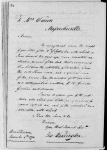- Letter from Warren to Catharine MacCaulay
- Letter to Warren from George Washinton
by Koren Whipp
Mercy Otis Warren (1728–1814), poet, essayist, historian, and America’s earliest-known female playwright, produced satirical political commentary which influenced public opinion, rallied opposition to British oppression and celebrated rebel victories. Mercy Otis was born in Barnstable, Massachusetts on September 14, 1728, eldest daughter of Mary Allyne Otis and James Otis Sr., who was farmer, merchant, attorney and later member of the Massachusetts House of Representatives. Although Warren had no formal education, her father permitted her to study with the Reverend Jonathan Russell while he tutored her brothers.[1]
Mercy Otis married her brother’s Harvard colleague and friend, James Warren in 1754 and they settled in Plymouth. James Warren, a gentlemen farmer and statesmen was elected to the Massachusetts House of Representatives in 1765 and eventually became speaker of the House and President of the Massachusetts Provincial Congress. Together they had five sons, James, Winslow, Charles, Henry, and George.
Supported by her political family, Warren voiced her political views through her anti-British and anti-Loyalist propaganda plays. Although her works were published anonymously until 1790, it was well-known in Boston society that Warren was their author. She formed a strong circle of correspondents which included John Adams, Abigail Adams, Hannah Winthrop and Catharine Macaulay.
The Warren’s Plymouth home became a meeting place for revolutionaries. Leading up to and during the revolution, Warren oversaw a household which flourished as the center of local radical politics, hosting the Sons of Liberty. The Warren home is also posited to be the site of the creation of the Committees of Correspondence.[2]
Published anonymously, excerpts from Warren’s first political play The Adulateur were previewed in the March 26, 1772, edition of Boston’s The Massachusetts’s Spy, a weekly political paper.[3] The Adulateur presents the fictional land of Servia and its attempts to throw off oppression. Theatrical metaphors were common in early American discourse and it would not have been difficult for readers to understand Servia as representative of Massachusetts.[4] The characters bore fictitious names but similarities to Boston politics enabled readers to recognize its main villain, Rapatio, as Thomas Hutchinson, Governor of Massachusetts. Hutchinson was much reviled by many colonists who considered him traitorous because he was American-born yet loyal to the Crown and a proponent of British taxation of the colonies. In Warren’s play, the American colonists are depicted as free-born sons of Servia whose liberties are being curtailed through the schemes of Rapatio/Hutchinson.
The Boston Tea Party of December 16, 1773, inspired Warren’s first published political poem. John Adams requested she write a tribute to commemorate the event based on an idea he outlined in a letter to her husband James Warren:
Make my Compliments to Mrs Warren and tell her that I want a poetical Genius,—to describe a late Frolic among the Sea Nymphs and Goddesses…I wish to See a late glorious Event, celebrated, by a certain poetical Pen, which has no equal that I know of in this Country.[5]
The resulting Squabble of the Sea Nymphs; or the Sacrifice of the Tuscararoes describes Neptune, having run out of nectar, summoning the gods. Subsequently, a quarrel ensues between the nymphs resulting in the spilling of tea throughout the ocean. Warren humanized and contemporized Adams’s nymphs and goddesses:
For females have their influence o’er kings, Nor wives, nor mistresses, were useless things. Ev’n to the gods of ancient Homer’s page; Then sure, in this polite and polish’d age, None will neglect the sex’s sage advice, When they engage in any point so nice, As to forbid the choice nectareus sip…[6]
In the poem’s conclusion, the “daughters” rejoiced over the “confusion round Neponset Hills,” signifying Massachusetts’s Governor, Thomas Hutchinson’s country mansion in Milton. John Adams arranged for the poem’s publication in the Boston Gazette calling it “one of the incontestable evidences of real genius.”[7]
Dr. John Winthrop, Professor of Mathematics and Natural Philosophy at Harvard College, was another who assisted Warren in publication. Husband to Warren’s close friend Hannah Winthrop, he suggested that Warren pen a poem to assist in the banning of trade with Britain in the critical year of 1774. The cooperation from women who bought British goods was essential in blocking British imports. In the poem which appeared in the Royal American Magazine in June 1774, Warren ridiculed the woman who was unwilling to “check her wanton pride, And lay her female ornaments aside.” Rather than do without these fineries and support their men in the fight for freedom, they would “live as vain fickle fortune’s sport, Amid the panders of a tyrant’s court.”[8] Warren alludes to several Roman matrons throughout the poem notable for their self-sacrifice for a cause or larger issue than self-indulgence, suggesting to American women that they had historical models for self-denial in service to republican ideals.[9]
In another propaganda poem, “A Political Reverie,” published in the Boston Gazette of February 13, 1775, Warren imagines a splendid future for America:
Has freedom’s genius left Britannia’s shore?
And must her sleeping patriots live no more?
Arise, ye venerable shades! inspire,
Each languid soul with patriotic fire;
‘Till every bosom feels a noble flame,
And emulates a Locke, or Sydney’s name.[10]
Warren laments the formerly revered Britain, which has become the enemy of liberty and virtue. She calls on the spirits to inspire the colonists with the patriotic fire of their ancestors who brought the political ideals of John Locke and Algernon Sidney from England. Her vision of honor and republican virtue is threaded throughout all of her poems and propaganda pieces to instruct and shape her readers’ views.
In 1787, as the draft of the Constitution was sent to the state conventions for ratification, Warren declared her opposition to the document. She believed that the proposed government would impose an alternative despotism on the American people. With no guarantees of individual liberties, too much power in the hands of the President, and new limitations attached to state’s rights, the Constitution was antithetical to the pure republicanism Warren advocated.[11] Warren published, anonymously, her Anti-Federalist position in Observations on the new Constitution, and on the Federal and State Conventions. By a Columbian Patriot (1788), in which she strongly defends her radical republicanism.[12] She argued for one-year terms and the right to recall elected officials by a popular mandate to reject their decisions, freedom of speech and of the press, she argued against a standing army, and demanded trial by jury in civil causes. Observations was long thought to be the work of other writers, most notably Elbridge Gerry. It was not until her descendent, Charles Warren, found a reference to it in a 1787 letter to British historian, Catharine Macaulay, that Warren was accredited authorship.[13] The political effect of Warren’s Observations is unknown; nevertheless a Bill of Rights which included many of Warren’s suggested additions to the Constitution was adopted by the House of Representatives in 1789.
History of the Rise, Progress, and Termination of the American Revolution completed in 1805, an enormous work covering three volumes and totaling more than 1,300 pages, was the first political text published under Warren’s name, the first history of the revolution penned by a woman, and the earliest-known example of public criticism of the Constitution.[14] Warren explains that she wrote the work because “a concern for the welfare of society ought equally to glow in every human breast.”[15] History is considered the only multi-volume Anti-Federalist history of the Revolution written by an eyewitness of the events.[16]
Mercy Otis Warren died on 19 October, 1814 at aged 86. She is buried at Burial Hill, Plymouth, MA.
Works:
Mercy Otis Warren, The Adulateur: A Tragedy, as it is Now Acted in Upper Servia 1773 (Dodo Press).
—, “The Blockheads,” 1776.
—,“The Defeat, 1773”. The Blockheads and The Defeat (Dodo Press).
—, “The Group,” 1775.
—, “The Motley Assembly,” 1779.
—, History of the Rise, Progress, and Termination of the American Revolution, Vol. 1. (Massachusetts: Applewood Books. 1805).
—, “Observations on the New Constitution, and on the Federal and State Conventions, by a Columbian Patriot” (Boston: 1788).
—, Plays and Poems of Mercy Otis Warren: Facsimile Reproductions Compiled and with an Introduction by Benjamin Franklin V. (Delmar, N.Y.: Scholars’ Facsimiles and Reprints, 1980).
—, Poems, Dramatic and Miscellaneous. (Printed at Boston : By I. Thomas and E.T. Andrews. At Faust’s Statue, no. 45, Newbury Street., MDCCXC. 1790).
[1] Maud Macdonald Hutcheson, “Mercy Warren, 1728-1814,” The William and Mary Quarterly, Third Series, 10, No. 3 (Jul., 1953), 383.
[2] Katharine Anthony, First Lady of the Revolution: The Life of Mercy Otis Warren (New York: Doubleday & Co. Inc., 1958), 78; and Joan Hoff Wilson and Sharon L. Bollinger, “Mercy Otis Warren: Playwright, Poet, and Historian of the American Revolution (American, 1728-1814),” Female Scholars: A Tradition of Learned Women Before 1800, J.R. Brink, ed. (Canada: Eden Press Women’s Publications, 1980), 161-182.
[3] Hutcheson, “Mercy Warren, 1728-1814,” 378-402.
[4] Sandra J. Sarkela, “Freedom’s Call: The Persuasive Power of Mercy Otis Warren’s Dramatic Sketches, 1772-1775,” Early American Literature, 44 Issue: 3. (2009), 541–68.
[5] John Adams to James Warren, December 22, 1773, “Papers of John Adams”, Volume 2, Founding Families: Digital Editions of the Papers of the Winthrops and the Adamses, ed. C. James Taylor. (Boston: Massachusetts Historical Society, 2007).
[6] Mercy Otis Warren. “Squabble of the Sea Nymphs; or the Sacrifice of the Tuscararoes,” Poems Dramatic and Miscellaneous (I. Thomas and E.T. Andrews, 1790), 203.
[7] Hutcheson, “Mercy Warren, 1728-1814,” 378-402.
[8] Hutcheson, “Mercy Warren, 1728-1814,” 378-402.
[9] Jeffrey H. Richards, Mercy Otis Warren (New York: Twayne Publishers, 1995), 58.
[10] Mercy Otis Warren, Poems, Dramatic and Miscellaneous (Boston: By I. Thomas and E.T. Andrews. At Faust’s Statue, no. 45, Newbury Street., MDCCXC. 1790), 192.
[11] Richards. Mercy Otis Warren, 121.
[12] Anti-Federalist’s were those opposed to a strong central government as they believed it threatened the sovereignty of states and individuals.
[13] Massachusetts Historical Society, Proceedings, XLV (19TI-I9I2), 335; Charles
Warren, “Ratification of the Federal Constitution,” as quoted in Hutchinson, Mercy Warren, 393. See also Kate Davies, Catharine Macaulay and Mercy Otis Warren: The Revolutionary Atlantic and the Politics of Gender (Oxford: Oxford University Press, 2005), 292.
[14] Lawrence J. Friedman, and Arthur H. Shaffer, “Mercy Otis Warren and the Politics of Historical Nationalism,’ The New England Quarterly vol. 48, No. 2 (Jun., 1975), 194-215.
[15] Warren, Mercy Otis. Lester H. Cohen, ed. and annotated. History of the Rise, Progress, and Termination of the American Revolution. Indiana: Liberty Fund, Vol. 1. (1994), xlii.
[16] Wilson, “Mercy Otis Warren,” 204.
Bibliography:
Cohen, Lester H. “Mercy Otis Warren: the Politics of Language and the Aesthetics of Self” American Quarterly. (1983): 481–98.
Davies, Kate. Catharine Macaulay and Mercy Otis Warren: The Revolutionary Atlantic and the Politics of Gender. Oxford: Oxford University Press, 2005.
—, “Revolutionary Correspondence: Reading Catharine Macaulay and Mercy Otis Warren” Women’s Writing: the Elizabethan to Victorian Period. (2006): 73–97.
Friedman, Lawrence J. and Shaffer, Arthur H. “Mercy Otis Warren and the Politics of Historical Nationalism” New England Quarterly. Vol. 48, No. 2. Jun., 1975: 194–215.
Gelles, Edith B. “Bonds of Friendship: the Correspondence of Abigail Adams and Mercy Otis Warren” Proceedings of the Massachusetts Historical Society. (1996): 35–71.
Hutcheson, Maud Macdonald. “Mercy Warren, 1728-1814” The William and Mary Quarterly. Third Series, Vol. 10. No. 3 (Jul., 1953): 378-402.
Lane, Larry M. and Judith J. Lane. “The Columbian Patriot: Mercy Otis Warren and the Constitution” Women & Politics. (1990): 17–32.
Oreovicz, Cheryl Z. “Mercy Otis Warren (1728–1814)” Legacy. (1996): 54–64.
Richards, Jeffrey H. Mercy Otis Warren. New York: Twayne Publishers, 1995.
Richards Jeffrey H. and Sharon M. Harris, Eds. Mercy Otis Warren: Selected Letters. Georgia: The University of Georgia Press. 2009.
Stuart, Nancy Rubin. “Conscience of the Revolution” American History. Vol. 43 Issue 3 (Aug. 2008): 50-55.
—,The Muse of the Revolution: The Secret Pen of Mercy Otis Warren and the Founding of a Nation. Boston: Beacon Press, 2008.
Sarkela, Sandra J. “Freedom’s Call: The Persuasive Power of Mercy Otis Warren’s Dramatic Sketches, 1772-1775” Early American Literature. Vol. 44 Issue 3 (2009): 541-68.
Warren, Mercy Otis. The Rise, Progress and Termination of the American Revolution, Interspersed with Biographical, Political and Moral Observations. Ed. and Ann. by Lester H. Cohen (2 vols.) Liberty Classics, 1988.
Zagarri, Rosemarie. A Woman’s Dilemma: Mercy Otis Warren and the American Revolution. Illiniois: Harlan Davidson, 1995.
—, Revolutionary Backlash: Women and Politics in the Early American Republic. Philadelphia: University of Pennsylvania Press. 2007.
Resources:
Brooklyn Museum
Elizabeth A. Sackler Center for Feminist Art: The Dinner Party: Heritage Floor: Mercy Otis Warren
http://www.brooklynmuseum.org/eascfa/dinner_party/heritage_floor/mercy_otis_warren.php
Page citation:
Koren Whipp. “Mercy Otis Warren.” Project Continua (June 23, 2013): Ver. 1, [date accessed], http://www.projectcontinua.org/mercy-otis-warren/
Tags: Enlightenment, Essayists, Historians, North America, Patriots, Playwrights, Poets



